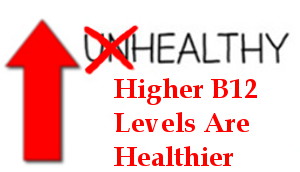
My all time favorite articles talk about healthy vitamin B12 levels being 500-550 pmol/mL and above. Japan’s low normal for B12, for instance, was 500-550 because at lower levels dementia and memory loss appear. Conversely, in the U.S. the low normal is 200 pmol/mL, the level at which blood abnormalities begin to appear. (Sadly, Japan has since lowered its level.)
Besides talking about healthy vitamin B12 levels, the researchers talk about people with gastritis and celiac disease. In each case the researchers suggest cobalamin/B12 therapy.
Overall, they conclude the current “low normal” for vitamin B12 of 200 needs reassessing.
For this reason, I don’t include a vitamin B12 levels chart on this page. Basically, all of the charts I’ve seen show very low vitamin B12 levels as normal. Perhaps in time charts will reliably show healthy vitamin B12 levels. That could, however, interfere with sales of certain prescription drugs.
Misleading vitamin B12 level charts
Charts showing B12 levels by age can be particularly misleading. Older people have lower vitamin B12 levels not because that is normal and good. Rather, lower levels result from lives in which stress and other factors lower vitamin B12 levels.
Had those people understood that higher vitamin B12 levels are healthier, they most likely would have used methylcobalamin. Methylcobalamin is form of vitamin B12 our bodies use. Or, they may have chosen to eat more Swiss cheese, and other cheeses with holes. Why would this matter? Because the bacteria responsible for the holes also make B12. By eating cheeses containing these bacteria, like Swiss cheese, you put these good bacteria into your digestive system where they can live happily, making B12 out of things, as for instance tomato sauce, that have no B12 in them. Vitamin B12 made by Swiss cheese bacteria comes in tiny amounts, but at the same time it’s a constant.
Rather than relying on charts, which may be misleading, refer to your fingernails for clues to the health of your B12 level.

1/18/2023 ~ I just received an email saying, “You don’t mention that Metformin, commonly used as the gold standard for diabetes treatment, blocks gastric intrinsic factor, leading to progressive vitamin B12 deficiency.”
To check this out I googled, “Metformin B12 Abstract” and found: Long-term Metformin Use and Vitamin B12 Deficiency in the Diabetes Prevention Program Outcomes Study, published in 2016. In Results, the study says, “Years of metformin use were associated with increased risk of B12 deficiency… (Anemia prevalence was higher in MET, but did not differ by B12 status. Neuropathy prevalence was higher in MET with low B12 levels.”
I’m grateful for the email alerting me to something that ought to be mentioned when talking about healthy B12 levels. And, I’ve updated this page, grateful to have this information I previously lacked.
My Favorite Articles
MOLNYCKE, SWEDEN. Swedish researchers have discovered that many older people are deficient in vitamin B-12. Their study involved 368 men and women aged 75 years or older. Analysis of blood serum showed that 11 per cent of the participants were deficient in cobalamin (vitamin B-12). The researchers point out that a vitamin B-12 deficiency has been linked to neuropsychiatric disorders such as memory loss and dementia. The researchers discovered several cases of gastritis (inflammation of the lining of the stomach) and two cases of celiac disease among patients with low serum values of cobalamin. They conclude that routine screening for a vitamin B-12 deficiency is justified in the case of older people.
In a separate letter to the Journal of the American Geriatrics Society doctors from the Union Memorial Hospital in Baltimore report on a case of vitamin B-12 deficiency. The patient, an 85-year-old man, had developed progressive memory loss and lethargy over a two-year period. Although his serum level of vitamin B-12 was within the currently accepted range, the doctors decided to proceed with vitamin B-12 therapy. The patient received an intramuscular injection of 1000 micrograms of vitamin B-12 for three consecutive days, then 1000 micrograms weekly for a month, and then one injection every month. By the fifth injection his mental status has vastly improved and his lethargy had completely vanished.
The doctors conclude that the levels of serum vitamin B-12 concentrations currently considered normal in the United States may be too low and should be reassessed. The lower limit of 200 pg/mL is based on the level which causes abnormalities in the blood (pernicious anemia). In contrast the lower limit in Japan and some European countries is 500-550 pg/mL and is based on the level which causes mental manifestations such as dementia and memory loss. The doctors suggest a trial of vitamin B-12 therapy in patients with borderline cobalamin serum levels as it is effective and inexpensive.
Eggersten, Robert, et al. Prevalence and diagnosis of cobalamin deficiency in older people, Journal of the American Geriatrics Society; Vol. 44, Nol. 10, October 1996, pp. 1273-74.
Goodman, Mark, et al. Are U.S. lower normal B-12 limits too low? Journal of the American Geriatrics Society, Vol. 44, No. 10, October 1996, pp. 1274-75.
Family Practice News reported on January 1, 2004 that 24% of people aged 60-69 had deficient levels of serum B12, defined as under 185 pmol/L.
Healthy vitamin B12 levels across the globe
The reference range for vitamin B12 in different countries varies. In fact, reference values may vary markedly among populations and cultures. One reason for this is that diet varies significantly. The laboratories of any particular country are expected to investigate values in relation to their population. But, the reference range seldom reflects healthy vitamin B12 levels.
Research at the beginning of this article says some European countries have low normals for B12 of 500-550, like Japan. But, Google has not helped me find which countries. It’s possible that since 1996 when the research was published drugs were developed to use for particular symptoms of low vitamin B12. Restless Leg Syndrome is one example. As pharma profited they may have shared a bit with laboratories to encourage continued use of the low normals in processing B12 tests.
Low normal for B12 in England
The low normal for vitamin B12 in England has been as low as 150. At 150 some patients had hair loss that was diagnosed as Alopecia, and said to be a permanent disorder. But, when those patients received B12 injections and reached healthy B12 levels their hair grew back and depression went away.
The doctor who most prescribed vitamin B12 instead of drugs came under fire from orthodox medicine.
Inside Out – Dr. Chandy and B12

The video is worth watching for its view of patient experience vs medical professionals’ opinion.
Doctors and General Practitioners (GPs) in England are advised that the ‘normal’ reference range of serum B12 in blood tests is between 180 – 1132 pmol/mL and that only deficiency needs to be treated. This often translates into denial of treatment for nerve disorders which are known to exist at low normal levels of vitamin B12. In fact some research articles say that although a patient’s vitamin B12 was raised to a normal level the nerve issue did not resolve.
Dr. Chandy’s approach differed from the medical norm in that he treated until the patient regained a much higher level of health. He treated based on visible health results, rather than achieving a particular blood test “score”.
I found that when I had to rely on US doctors for an injectable cobalamin prescription they did not take my reports of how the injections helped me as meaningful. Begging fell on deaf ears. It was only when I discovered that Methylcobalamin lozenges work as well as injections that I was able to maintain higher levels of health for myself.
In England doctors generally treat vitamin B12 deficiency by intramuscular (IM) injection, and no more than once every three months.
It is hopeful, however, that recent research from Oxford University has suggested that 300 pmol/mL might be a more accurate lower limit than 180. And, there is some suggestion that 500 pmol/mL might be an even more accurate lower required limit.
Australia’s vitamin B12 range
Australia’s reference range for vitamin B12 is 135-650 pmol/L. Clinical cases show B12 deficiency symptoms within the reference range.
Canada‘s vitamin B12 range
Sufficient vitamin B12 levels are those greater than or equal to Health Canada’s recommendation of 148 pmol/L. In a recent email I received, a Canadian wrote that the range on her report is 138 to 652. She wrote, “The report (requested by my doctor), was from my blood samples, taken and analyzed by LifeLabs Medical Laboratories in Milton, Ontario (1/2 hour west of Toronto, Canada).”
Germany‘s vitamin B12 range
German research states that if the total vitamin B12 concentration is in the lower reference range, 156 to 400 pmol/L, then vitamin B12 deficiency cannot be ruled out; and, clinical signs of vitamin B12 deficiency can be seen in persons with vitamin B12 concentrations lower than 156 pmol/L.
Japan’s vitamin B12 range
Japan raised its B12 reference range to 500 – 1300 Pmol in the 1980s. In 2018, however, when I asked Ian Chun, CEO of Yunomi Tea, if he would find the range for me, he wrote back:
I can’t find an official number
Another one 233~914 pg/mL
Korea’s vitamin B12 range
A study showed Korean centenarians’ serum vitamin B12 to be 393.2 pg/mL in males, 405.5 pg/mL in females despite lifelong diets of grains and vegetables.
Traditional home-made fermented soybean foods such as Doenjang, Gochujang and Chungkookjang contain higher amounts of vitamin B12 than factory-made.
Home-made Doenjang, a “slow food” takes 10 months for preparation/fermentation by natural microorganisms. The commercial product takes 3-4 months, fermenting with inoculated microorganisms under strict conditions. The smell involved in making Doenjang, has increased the popularity of commercial Doenjang among younger generations in urban areas. Korean centenarians in the study were consuming traditional home-made fermented foods.
Next, most Koreans eat Kimchi, a fermented vegetable food, at almost every meal. Cabbage Kimchi is popular and made of salted Chinese cabbage, red pepper, garlic, fermented fish sauce or/and fermented small fish, green onion, ginger, starch, and other optional vegetables. Fermentation runs from a few days to months in low temperatures.
Kimchi’s vitamin B12 content derives from the fermented fish sauce.
Korean centenarians don’t use supplements, and few B12 fortified foods exist in Korea. Some edible algae and seaweed, including laver, contain large amounts of B12 but there’s debate as to bioavailability. Be that as it may, high consumption of seaweeds would be partly responsible for the normal status of vitamin B12.
Discovery of Novel Sources of Vitamin B12 in Traditional Korean Foods. From Nutritional Surveys of Centenarians. Chung Shil Kwak, Mee Sook Lee, Se In Oh, and Sang Chul Park, 2010.
Netherlands’ vitamin B12 range
Serum vitamin B12 level cut-off 145 pmol/L. A cut-off level is the point which segregates a result as being either positive or negative.
Pakistan’s vitamin B12 range
Lower limit of serum vitamin B12 in healthy individuals varies from 150 to 300 pg/ml. The upper limit varies from 635 to 925 pg/nil.
Poland’s vitamin B12 range
Normal range: 180-900
Russia’s vitamin B12 range
B12/Cobalamin lack begins at a level less than 200 (<200 ng/l). Cobalamin deficiency is 150 ng/l or lower.
Sweden’s vitamin B12 range
Sweden accepts a low vitamin B12 level of 152 as normal. Sweden’s standard laboratory range for vitamin B12 is 152–568 pmol l.
Turkey’s vitamin B12 range
Normal reference levels obtained for vitamin B12: 127-606 pg/mL for girls, 127-576 pg/mL for boys, and 127-590 pg/mL for the entire study group.
Uganda’s vitamin B12 range
A study seeking to establish vitamin B12 reference values for young Ugandan adults, to be used as baseline information, found a range of 117–1158 pg/ml. This range was adjusted “to the 2.5th to 97.5th percentile” to read as 152 to 1029 pg/ml. These results were considered to show no borderline or actual deficiency. The results were considered comparable to values obtained in Germany of 191 – 663 pg/ml and the USA of 211 – 946 pg/ml.
United States’ vitamin B12 range
Normal values are 200 to 900 picograms per milliliter (pg/mL).
Normal value ranges may vary slightly among different laboratories. Some labs use different measurements or may test different samples. Talk to your provider about what your specific test results mean.
Labs are quick to say “what abnormal results mean”. As for instance, “Values of less than 200 pg/mL are a possible sign of a vitamin B12 deficiency.” Labs fail to test for or talk about healthy vitamin B12 levels.
High-dose B12 prevents Alzheimer’s Disease

From the Townsend Letter for Doctors and Patients – 2006
It’s interesting to consider what proportion of Alzheimer’s Dementia (AD) may result from under-nutrition. Especially when low-cost, perfectly safe nutrition may allow people to avoid a miserable illness some consider worse than death. People might say, “That’s too good to be true!” But, an at-home nutritional program, using a lot of vitamin B12 may indeed prevent and virtually eliminate AD. Early treatment soon after first warning symptoms could turn off the process.
Confusion, difficulty concentrating, memory loss, marked personality changes, violent outbursts, wandering away, and early death all characterize Alzheimer’s dementia. And, AD prevalence doubles every five years after the age of 60.

Let’s start with a little background. Mammals, including humans, are born with serum levels of vitamin B12 at about 2,000 pg/ml. The level declines throughout human life. Below 550 to 600 pg/ml, deficiencies start to appear in the cerebrospinal fluid. But, US clinical laboratories regard 200 pg/ml as the lower range of normal.
“Most cases of Alzheimer’s dementia are actually missed B12 deficiency cases, because of the too-low normal range for B12,” according to John V. Dommisse, MD, in Medical Hypotheses, 1991. His work confirmed that Alzheimer’s results from too-low serum vitamin B12, and, that B12 repletion succeeds despite other risk factors. “Repleting B12 reverses 75% of B12 deficiency dementias when the condition is discovered early enough.”

In comparison to reducing hematologic effects of B12 deficiency, reducing neurological and cerebral manifestations of B12 deficiency requires larger dosages over more time. B12 therapy appears to be perfectly safe; in other words, the risk of overdose is virtually nil. Patients of Dr. H.L. Newbold in New York City injected themselves three times daily with triple-strength doses of B12 (9,000 ug/micrograms/per day) indefinitely. Their serum B12 levels reached 200,000 pg/ml but none had any significant side effects.
Healthy vitamin B12 levels prevent birth defects
WASHINGTON (Reuters) – Before becoming pregnant, women need to get enough vitamin B12 in addition to folic acid to cut their risk of having a baby with a serious birth defect of the brain and spinal cord, researchers wrote in the journal Pediatrics.
Their study involved 1,200 women in Ireland. And, showed that those with lowest B12 levels were five times more likely to have babies with neural tube defects.
Neural tube defects lead to lifelong disability or death. The most common ones are spina bifida, where the spinal cord and back bones do not form properly, and anencephaly, a fatal condition in which the brain and skull bones do not develop normally.
Dr. Mills, a researcher in NIH’s National Institute of Child Health and Human Development, said he hopes awareness of the role of vitamin B12 reduces neural tube defects.
“An absolutely critical point is that women have to consider this before they become pregnant because once they realize they are pregnant it’s likely to be too late. The developmental events involved in these birth defects occur in the first four weeks of pregnancy,” Mills said.
Mills urged vegetarian and vegan women and those with inflammatory bowel disease preventing B12 absorption to be aware of B12.
The researchers suggested that healthy vitamin B12 levels for women before getting pregnant should be above 300 nanograms per liter.
Vitamin B12 Research
In reading vitamin B12 research I’ve noticed that older research found vitamin B12 to positively help in various diseases and conditions, while newer research questions how much it helps. Newer research appears (to me) prejudiced against vitamins in order to favor prescriptions. Pharma likely pays for the research that makes prescription drugs seem the better choice. In concert with that, a very low “low normal” increases the need for medical help and prescription sales benefit.

